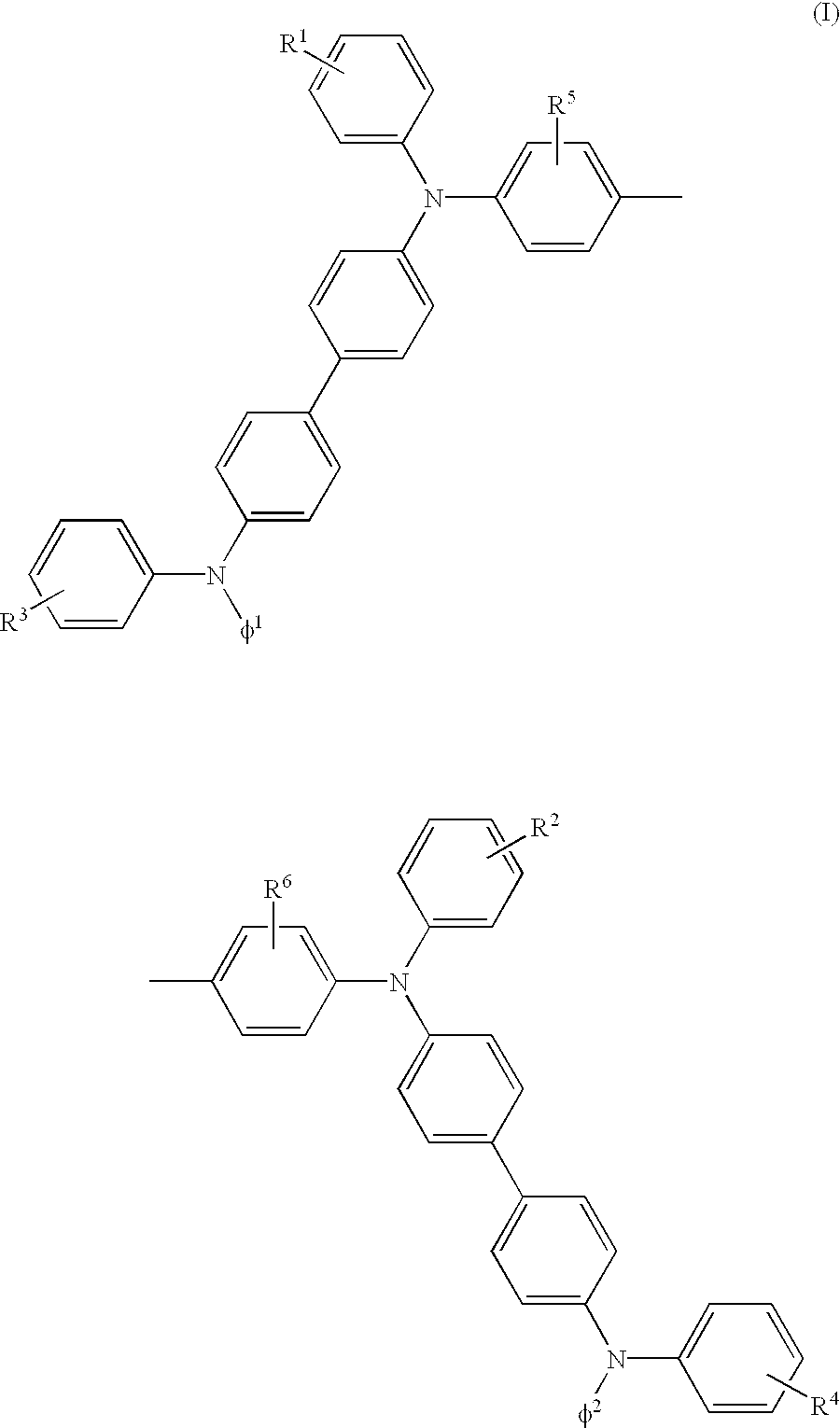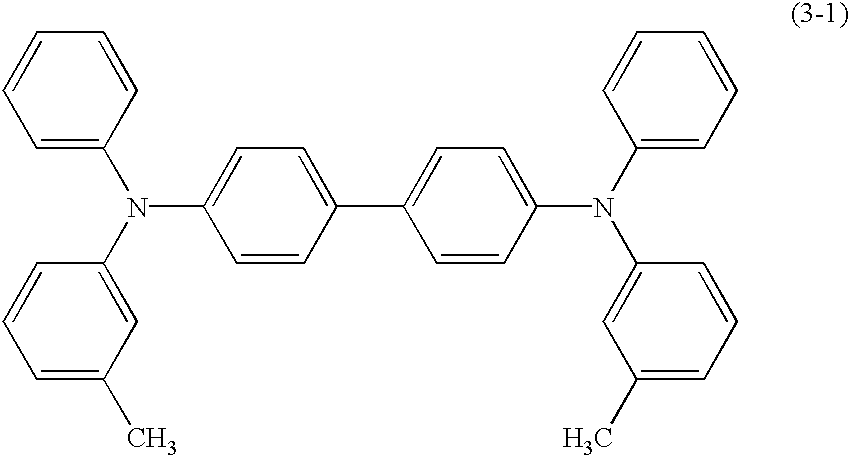Triphenylamine derivative and organic electroluminescence device comprising the same
a technology of organic electroluminescence and triphenylamine, which is applied in the preparation of amino compounds, natural mineral layered products, instruments, etc., can solve the problems of insufficient stability and durability of organic electroluminescence devices, deterioration of carrier injection efficiency, etc., and achieves improved heat resistance and high hole-transporting capacity.
- Summary
- Abstract
- Description
- Claims
- Application Information
AI Technical Summary
Benefits of technology
Problems solved by technology
Method used
Image
Examples
synthesis example 1
[0129] A suspension obtained by adding to 50 ml of decalin 15.0 g (68.4 mmol) of N-phenyl-N-(2-naphthyl)amine, 27.8 g (68.40 mmol) of 4,4'-diodobiphenyl represented by the formula (1b), 18.9 g (136.81 mmol) of potassium carbonate and 0.9 g (13.68 mmol) of copper powder was heated to a 200.degree. C. with stirring in a stream of argon to undergo reaction for 4 days.
[0130] To the reaction solution were then added 4.7 g (34.20 mmol) of potassium carbonate and 0.9 g (13.68 mmol) of copper powder. The reaction solution was then allowed to undergo reaction under the same conditions for 4 days.
[0131] The reaction solution was then filtered while being kept at the high temperature to remove insoluble matters therefrom. The filtrate was then washed with toluene.
[0132] The filtrate was allowed to cool, again filtered to remove 4,4'-diodobiphenyl therefrom, washed with ethyl acetate, and then subjected to distillation under reduced pressure to remove the solvent therefrom.
[0133] The residue wa...
synthesis example 2
[0143] 70.2 g of 4-(N-phenyl-N-(2-naphthyl))amino-4'-iodobiphenyl represented by the foregoing formula (1c) synthesized in the same manner as in Synthesis Example 1 and 12.0 g (56.53 mmol) of 3,3'-dimethylbenzidine represented by the following formula (1e): 25
[0144] were allowed to undergo reaction in the presence of 27.3 g (197.84 mmol) of potassium carbonate and 1.1 g (16.96 mmol) of copper powder in decalin at a temperature of 140.degree. C. for days. The reaction product was then column-purified with 1 kg of silica gel to obtain N,N'-bis(N-phenyl-N-(2-naphthyl)-4'-aminobiphenyl-4-il)-1,1'-biphenyl-3,3- '-dimethyl-4,4'-diamine represented by the following formula (1f). 26
[0145] 21.4 g (22.50 mmol) of N,N'-bis(N-phenyl-N-(2-naphthyl)-4'-aminobip- henyl-4-il)-1,1'-biphenyl-3,3'-dimethyl-4,4'-diamine thus obtained and 10.1 g (49.49 mmol) of iodobenzene represented by the following formula (1g): 27
[0146] were then allowed to undergo reaction in the presence of 27.3 g (197.84 mmol) of...
example 1
[0155] A glass substrate with a size of 25 mm long.times.25 mm wide.times.1 mm thick having an ITO electrically-conductive transparent layer formed by sputtering process on one side thereof as an anode was supersonically cleaned sequentially with a surface active agent and an organic solvent, and then subjected to ultraviolet ozone treatment so that it was cleaned.
[0156] Subsequently, the foregoing glass substrate was placed in a vacuum evaporation apparatus where the following various layers were then sequentially deposited on the surface thereof by vacuum evaporation method at a pressure of from 10.sup.-6 to 10.sup.-7 torr.
[0157] (1) A hole-transporting layer having a thickness of 60 nm formed by vacuum-evaporating NPTE-1 synthesized in Synthesis Example 1 as a hole-transporting material from a quartz crucible disposed in the vacuum evaporation apparatus by resistance heating method;
[0158] (2) An electron-transporting layer having a thickness of 60 nm formed by vacuum-evaporating ...
PUM
| Property | Measurement | Unit |
|---|---|---|
| RH | aaaaa | aaaaa |
| temperature | aaaaa | aaaaa |
| temperature | aaaaa | aaaaa |
Abstract
Description
Claims
Application Information
 Login to View More
Login to View More - R&D
- Intellectual Property
- Life Sciences
- Materials
- Tech Scout
- Unparalleled Data Quality
- Higher Quality Content
- 60% Fewer Hallucinations
Browse by: Latest US Patents, China's latest patents, Technical Efficacy Thesaurus, Application Domain, Technology Topic, Popular Technical Reports.
© 2025 PatSnap. All rights reserved.Legal|Privacy policy|Modern Slavery Act Transparency Statement|Sitemap|About US| Contact US: help@patsnap.com



